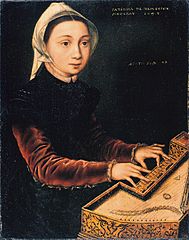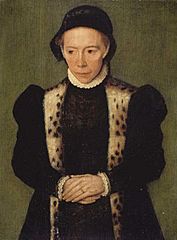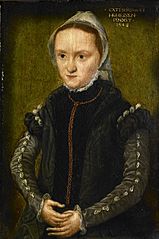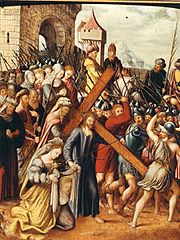Catharina van Hemessen facts for kids
Quick facts for kids
Catharina van Hemessen
|
|
|---|---|

Self portrait, 1548. This self-portrait may be the first self-portrait of an artist at work at the easel, regardless of gender.
|
|
| Born | 1528 |
| Died | after 1565 |
| Nationality | Flemish |
| Known for | portrait painting, some religious |
| Movement | Northern Renaissance |
| Spouse(s) | Christian de Morien |
| Patron(s) | Maria of Austria |
Catharina van Hemessen (born 1528, died after 1565) was an important Flemish painter during the Renaissance period. She is known as the first female Flemish painter whose works we can still see today. Catharina mostly painted small portraits of women and some religious scenes.
She is famous for creating what might be the very first self-portrait of an artist (male or female) shown painting at an easel. This special painting, made in 1548, shows Catharina starting a new portrait. You can see it today at the Kunstmuseum Basel in Switzerland. Other paintings by Catharina van Hemessen are in the Rijksmuseum in Amsterdam and the National Gallery in London.
In her time, it was very hard for women to become painters. Most female artists were taught by a family member. Catharina was lucky because her father, Jan Sanders van Hemessen, was also a painter and taught her.
Contents
Life of Catharina van Hemessen
Catharina van Hemessen was the daughter of Jan Sanders van Hemessen (around 1500-after 1563). Her father was a well-known Mannerist painter in Antwerp, who had studied art in Italy. It is believed he was her teacher. She likely helped him with many of his paintings.
Catharina became a master in the Guild of Saint Luke in Antwerp. This was an important art group. She even taught three students herself.
She was a very successful painter during her lifetime. In the 1540s, she found an important supporter: Maria of Austria. Maria was the ruler of the Low Countries (modern-day Belgium, Netherlands, Luxembourg).
In 1554, Catharina married Christian de Morien. He was an organist at the Antwerp Cathedral. This was a very respected job back then. In 1556, Maria of Austria moved to Spain. She invited Catharina and her husband to come with her.
Two years later, when Maria died, Catharina received a good pension for life. A pension is like a regular payment. Catharina and her husband then moved back to Antwerp. They were recorded there in 1561. They did not have any children. Around 1565, her husband got a job in 's-Hertogenbosch, and they moved there.
Catharina's Artworks
Catharina van Hemessen mainly painted portraits. She also created at least two religious paintings. Eight small portraits and two religious pictures have survived. They are dated between 1548 and 1552 and have her signature.
She often painted wealthy men and women. They were usually shown against a dark background. The people in her paintings look delicate and charming. They wear stylish clothes and accessories.
Her most famous work is her self-portrait at the Kunstmuseum Basel. On it, she wrote in Latin: "I Caterina van Hemessen have painted myself / 1548 / Her age 20". This means she was 20 years old when she painted it.
In 1548, she also painted Woman At Virginals. This painting might be a portrait of her sister, Christina. It is thought that her self-portrait and Woman At Virginals were a pair. They were meant to be hung together.
Catharina's portraits are known for looking very real. The people she painted were often sitting down. They were usually shown against a dark or plain background. Their eyes rarely looked directly at the viewer. This style made the portraits feel personal and respectful.
She also made religious paintings, but these were generally not as well-known as her portraits. There are no known works by her after 1554. This makes some historians think her art career might have ended after she got married. This was common for female artists at the time. Even after she stopped painting, Catharina still taught three male students.
Selected works
- Portrait of a Lady, 1551, National Gallery, London
- Portrait of a Lady in 16th Century Dress, Bowes Museum
- Young Woman Playing the Virginals, 1548, Cologne, Wallraf-Richartz Museum
Images for kids
-
Portrait of a Lady, c. 1551. Bowes Museum, County Durham
Gallery
See also
 In Spanish: Catharina van Hemessen para niños
In Spanish: Catharina van Hemessen para niños






